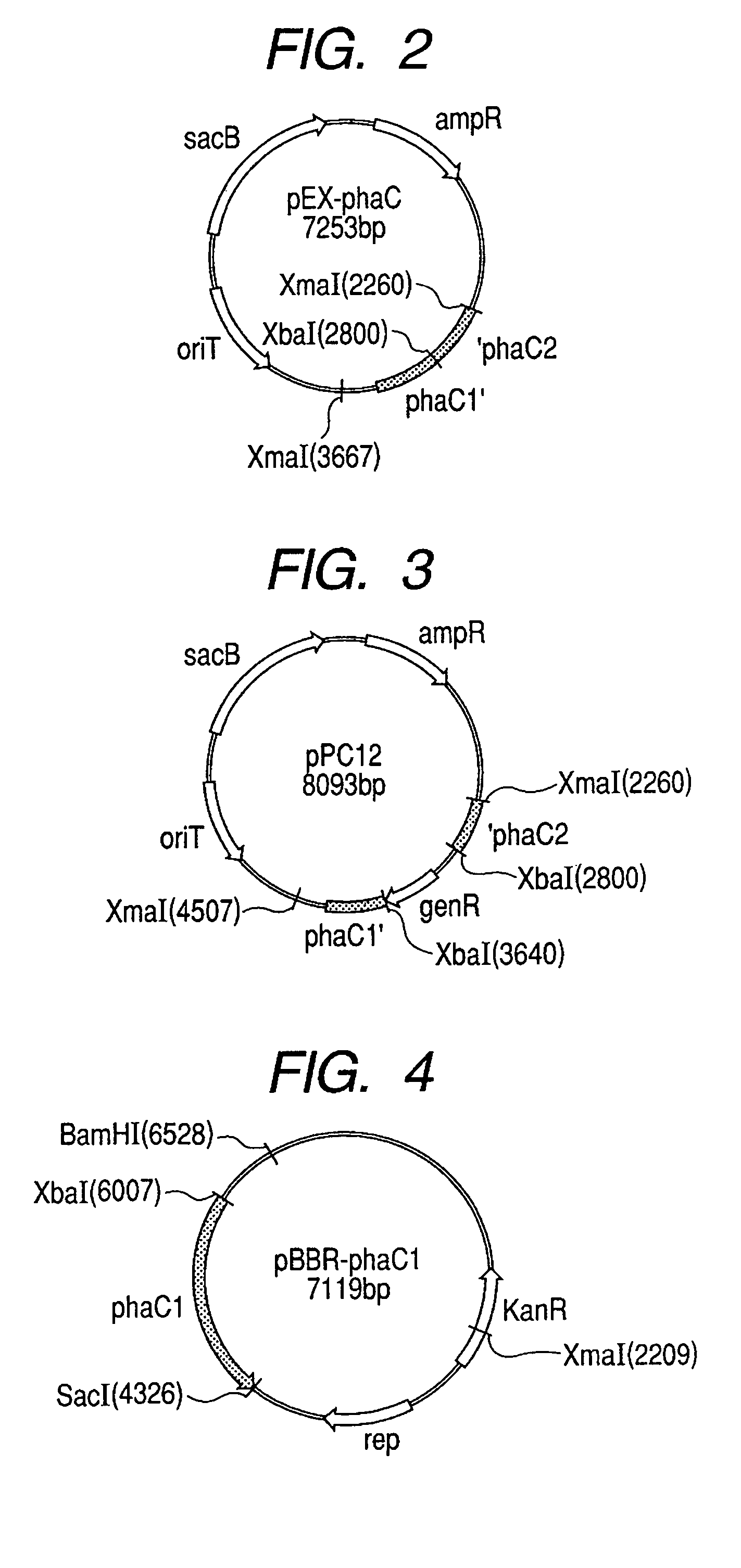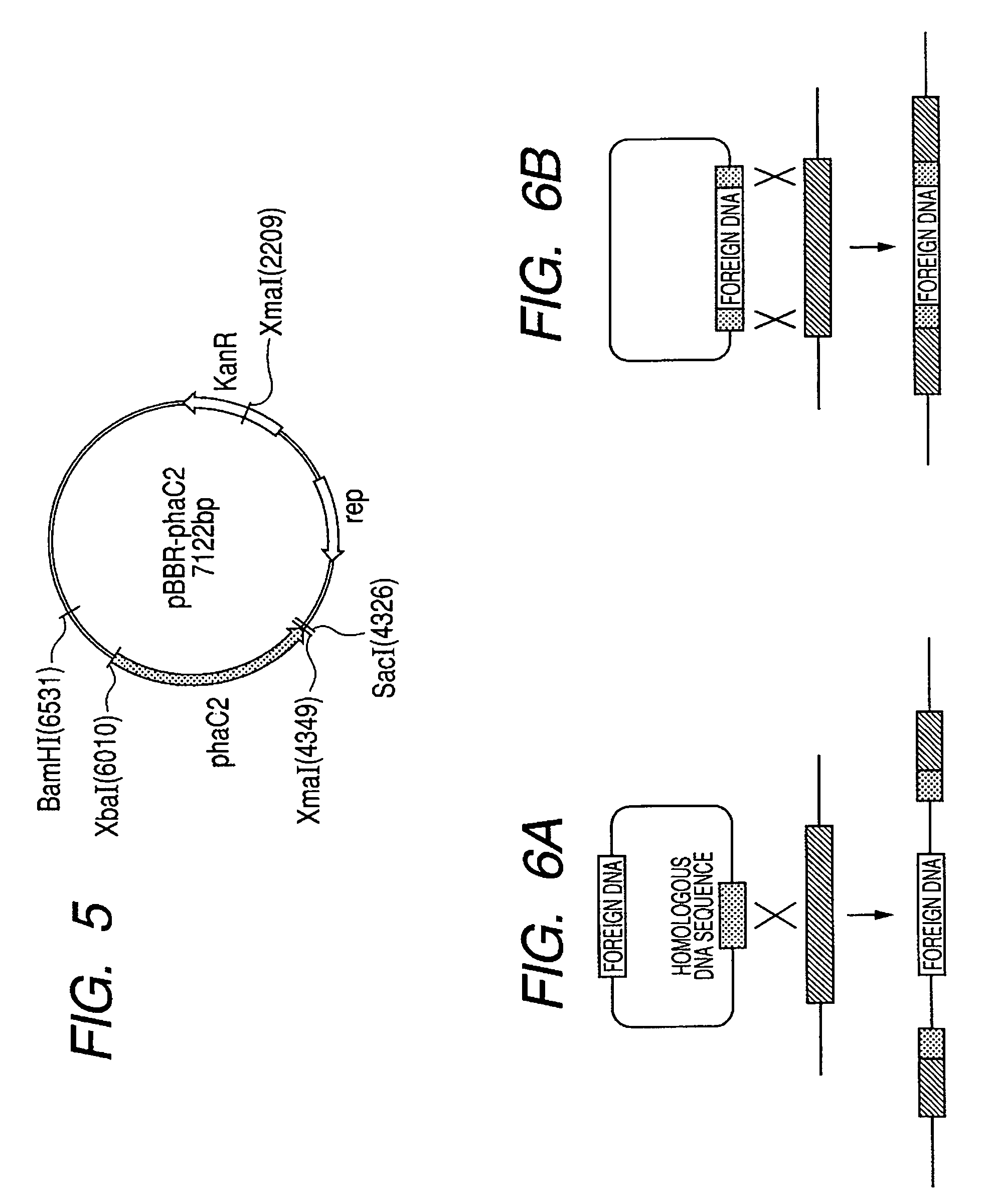Isogenic strain line of bacterium for producing polyhydroxyalkanoate in which polyhydroxyalkanoate synthase gene is disrupted and method for producing polyhydroxyalkanoate using the same
a technology of polyhydroxyalkanoate and strain line, which is applied in the direction of enzymology, transferases, and bacteria based processes, can solve the problems of inability to utilize, and achieve the effect of high efficiency
- Summary
- Abstract
- Description
- Claims
- Application Information
AI Technical Summary
Benefits of technology
Problems solved by technology
Method used
Image
Examples
example
Example 1
[0331]Since the result of pre-investigation of the drug resistance of the bacterium for producing polyhydroxyalkanoate, Pseudomonas species YN21 strain (FERM BP-08569) revealed that it is resistant to ampicillin and chloramphenicol and sensitive to gentamicin, the polyhydroxyalkanoate synthase gene targeting vector was constructed using the gentamicin resistant gene as a marker. The gene disruption vector constructed is a circular plasmid DNA (pPC21(SEQ ID NO: 10)) containing the partial base sequence from the base number 331 to 1215 of the base sequence shown in SEQ ID NO: 1 and the partial base sequence from the base number 1040 to 1667 shown in SEQ ID NO: 2. Following is the description of the procedure. FIG. 1 illustrates the summary of the procedure.
1) Preparation of Genomic DNA
[0332]Pseudomonas species YN21 strain was cultured in M9 medium containing 0.5% (w / v) of polypeptone at 30° C. for 24 hr. After harvesting the cells from the culture broth, the genomic DNA of YN...
example 2
[Acquisition of Pseudomonas Species PC12 Strain (FERM BP-08570), the Isogenic Strain Line of the Bacterium for Producing Polyhydroxyalkanoate, in which the Polyhydroxyalkanoate Synthase Gene is Disrupted]
[0354]The mobilizing strain Escherichia coli S17-1 (ATCC No. 47055) was transformed by the electroporation method with the polyhydroxyalkanoate synthase gene targeting vector (plasmid pPC12, SEQ ID NO: 10) that is constructed in Example 1. The electroporation was carried out in the condition of 2.5 kV, 25 μF, 200Ω using a cell with 0.2 cm gap (Gene Pulser Cuvette 0.2 cm, BioRad Ltd.) and a commercially available electroporation device (Gene Pulser, manufactured by BioRad Inc.). The S17-1 strain transformed with pPC12, obtained as colonies capable of growing on LB agar plate containing 15 μg / ml of gentamicin, was cultured in 5 ml of LB liquid medium containing 100 μg / ml of ampicillin at 30° C. for 12 hr with shaking. Also, Pseudomonas species YN21 strain was cultured in 5 ml of LB li...
example 3
[Construction of the Expression Vector for the Polyhydroxyalkanoate Synthase Gene (phaC1) Gene]
6) Preparation of Insert DNA
[0359]PCR (polymerase chain reaction) was carried out using the genomic DNA of YN21 strain prepared in 1) of Example 1 as a template and DNAs having the base sequence shown in YC1-upN-f1 (SEQ ID NO: 11) and YC1-N-r1 (SEQ ID NO: 12) as primers. Following reaction mixture was prepared.
[0360]
TABLE 9Template (genomic DNA derived from YN21)250ngPrimer YC1-upN-f1 (SEQ ID NO: 11)250pmolPrimer YC1-N-r1 (SEQ ID NO: 12)250pmol10-fold amplification buffer5μldNTP400μMTaq polymerase (LA-Taq, manufactured by2.5UTakara Shuzo Co., Ltd.)Sterile distilled waterAppropriateamountTotal50μl
[0361]The PCR was carried out for 30 cycles of a series of treatments of: denaturation [98° C. for 20 sec]; annealing [65° C. for 20 sec]; elongation [72° C. for 1 min]. PCR products were confirmed by agarose gel electrophoresis (gel concentration: 1 wt %). As a result, a fragment of about 530 base...
PUM
| Property | Measurement | Unit |
|---|---|---|
| molecular weight | aaaaa | aaaaa |
| temperature | aaaaa | aaaaa |
| temperature | aaaaa | aaaaa |
Abstract
Description
Claims
Application Information
 Login to View More
Login to View More - R&D
- Intellectual Property
- Life Sciences
- Materials
- Tech Scout
- Unparalleled Data Quality
- Higher Quality Content
- 60% Fewer Hallucinations
Browse by: Latest US Patents, China's latest patents, Technical Efficacy Thesaurus, Application Domain, Technology Topic, Popular Technical Reports.
© 2025 PatSnap. All rights reserved.Legal|Privacy policy|Modern Slavery Act Transparency Statement|Sitemap|About US| Contact US: help@patsnap.com



